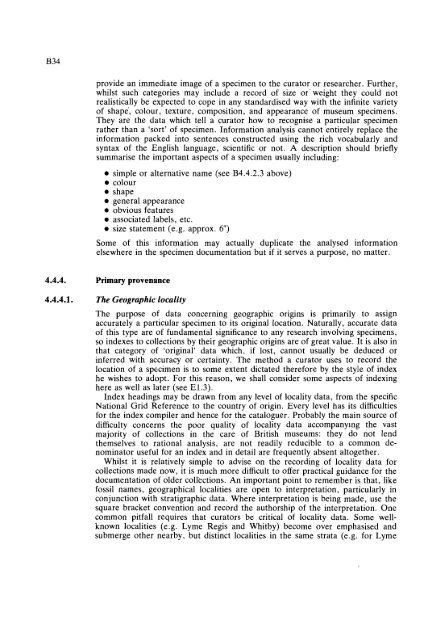GUIDELINES FOR THE CURATION OF GEOLOGICAL MATERIALS
GUIDELINES FOR THE CURATION OF GEOLOGICAL MATERIALS
GUIDELINES FOR THE CURATION OF GEOLOGICAL MATERIALS
Create successful ePaper yourself
Turn your PDF publications into a flip-book with our unique Google optimized e-Paper software.
provide an immediate image of a specimen to the curator or researcher. Further,<br />
whilst such categories may include a record of size or'weight they could not<br />
realistically be expected to cope in any standardised way with the infinite variety<br />
of shape, colour, texture, composition, and appearance of museum specimens.<br />
They are the data which tell a curator how to recognise a particular specimen<br />
rather than a 'sort' of specimen. Information analysis cannot entirely replace the<br />
information packed into sentences constructed using the rich vocabularly and<br />
syntax of the English language, scientific or not. A description should briefly<br />
summarise the important aspects of a specimen usually including:<br />
simple or alternative name (see B4.4.2.3 above)<br />
colour<br />
shape<br />
general appearance<br />
obvious features<br />
associated labels, etc.<br />
size statement (e.g. approx. 6 )<br />
Some of this information may actually duplicate the analysed information<br />
elsewhere in the specimen documentation but if it serves a purpose, no matter.<br />
Primary provenance<br />
The Geographiclocality<br />
The purpose of data concerning geographic origins is primarily to assign<br />
accurately a particular specimen to its original location. Naturally, accurate data<br />
of this type are of fundamental significance to any research involving specimens,<br />
so indexes to collections by their geographic origins are of great value. It is also in<br />
that category of 'original' data which, if lost, cannot usually be deduced or<br />
inferred with accuracy or certainty. The method a curator uses to record the<br />
location of a specimen is to some extent dictated therefore by the style of index<br />
he wishes to adopt. For this reason, we shall consider some aspects of indexing<br />
here as well as later (see E1.3).<br />
Index headings may be drawn from any level of locality data, from the specific<br />
National Grid Reference to the country of origin. Every level has its difficulties<br />
for the index compiler and hence for the cataloguer. Probably the main source of<br />
difficulty concerils the poor quality of locality data accompanying the vast<br />
majority of collections in the care of British museums: they do not lend<br />
themselves to rational analysis, are not readily reducible to a common denominator<br />
useful for an index and in detail are frequently absent altogether.<br />
Whilst it is relatively simple to advise on the recording of locality data for<br />
collections made now, it is much more difficult to offer practical guidance for the<br />
documentation of older collections. An important point to remember is that, like<br />
fossil names, geographical localities are open to interpretation, particularly in<br />
conjunction with stratigraphic data. Where interpretation is being made, use the<br />
square bracket convention and record the authorship of the interpretation. One<br />
common pitfall requires that curators be critical of locality data. Some wellknown<br />
localities (e.g. Lyme Regis and Whitby) become over emphasised and<br />
submerge other nearby, but distinct localities in the same strata (e.g. for Lyme

















